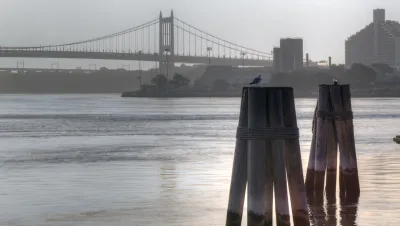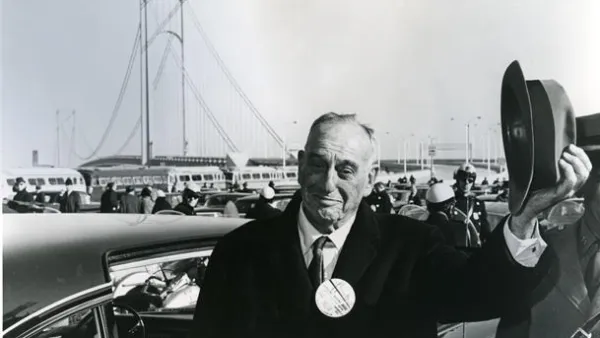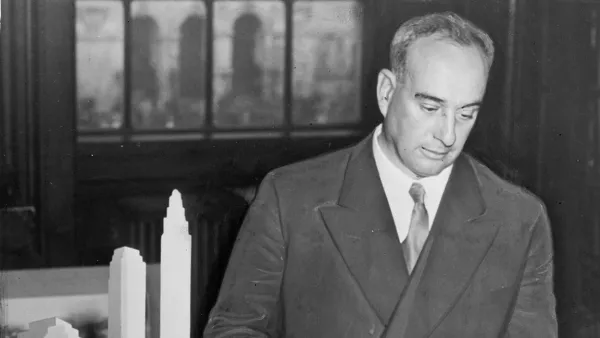A visit from the Dutch Prime Minister Mark Rutte to see Robert Caro, author of "The Power Broker," provides a refresher on the works of Robert Moses and Caro's writing.

Dutch Prime Minister Rutte and a friend were greatly influenced by Caro's epic biography, The Power Broker: Robert Moses and the Fall of New York. The two met up with Caro who had agreed to "show them some sights from the book," writes John Leland of The New York Times. Leland joined them in a narrated auto trip by the master historian to visit a handful of Moses' many creations.
Mr. Caro...pointed out Moses handiwork, which was basically everything in sight: the Robert F. Kennedy Bridge (formerly the Triborough Bridge), the northern extension of the F.D.R. Drive, the massive public housing projects in Queens and Upper Manhattan.
“Every building you see here was built by Robert Moses,” Mr. Caro said, gesturing toward the projects. “And there’s not a single architectural element to make them look better. Moses wanted the people living in them to feel poor.”
First stop was Randall Island, where Moses' main office for the Triborough Bridge Authority was located, directly below from where the three spans of the bridge (from three boroughs) meet. The bridge opened in 1936.
The Triborough Bridge Authority is now part of the Metropolitan Transportation Authority, which Gov. Nelson A. Rockefeller created to force Moses from power, Mr. Caro said. “It was the only way to get him out. Moses didn’t think it could be done.”
"MTA Bridges and Tunnels, legally known as the Triborough Bridge and Tunnel Authority, is an affiliate agency of the Metropolitan Transportation Authority, that operates seven intrastate toll bridges and two tunnels in New York City," according to Wikipedia.
Next up: "The Cross-Bronx Expressway, whose construction devastated a mile-long swath of the Bronx, uprooting a stable low-income neighborhood and leaving urban misery in its place," writes Leland.
When Mr. Caro was working on that part of the book, he said, it made him depressed and angry. He’d track down people who had been displaced, and the word they used to describe their lives afterward was “lonely.”
The Sheridan Expressway, also built by Moses, abuts the Cross-Bronx. It is budgeted to be razed and replaced with a ped/bike-friendly urban boulevard, as noted recently in a post that shows how far we have come from the destructive transportation policies embraced by Moses.
"Much has changed since “The Power Broker” came out in 1974, when it earned its subtitle about “The Fall of New York," writes Leland. "Mr. Caro said the subtitle reflected the city as Moses left it: crime rising, schools decaying, the city’s finances crumbling."
For Mr. Rutte, a lesson of the intervening years was that “leadership does matter,” he said, adding: “I used to walk in the Bowery in the early 1980s and it was not safe. It went from this to Disneyland under Giuliani and Bloomberg. This is now one of the best-run big cities in the world.”
Times have indeed changed in New York City since Moses' reign. Instead of building roadways that destroy neighborhoods, Mayor Michael Bloomberg and Transportation Commissioner Janette Sadik-Khan pedestrianized parts of Broadway with new plazas. Mayor Bill de Blasio continues in that vein with Transportation Commissioner Polly Trottenberg by taming notorious Queens Boulevard.
FULL STORY: The Dutch Prime Minister Is a Big Fan of Robert Caro

National Parks Layoffs Will Cause Communities to Lose Billions
Thousands of essential park workers were laid off this week, just before the busy spring break season.

Retro-silient?: America’s First “Eco-burb,” The Woodlands Turns 50
A master-planned community north of Houston offers lessons on green infrastructure and resilient design, but falls short of its founder’s lofty affordability and walkability goals.

Delivering for America Plan Will Downgrade Mail Service in at Least 49.5 Percent of Zip Codes
Republican and Democrat lawmakers criticize the plan for its disproportionate negative impact on rural communities.

Test News Post 1
This is a summary

Test News Headline 46
Test for the image on the front page.

Balancing Bombs and Butterflies: How the National Guard Protects a Rare Species
The National Guard at Fort Indiantown Gap uses GIS technology and land management strategies to balance military training with conservation efforts, ensuring the survival of the rare eastern regal fritillary butterfly.
Urban Design for Planners 1: Software Tools
This six-course series explores essential urban design concepts using open source software and equips planners with the tools they need to participate fully in the urban design process.
Planning for Universal Design
Learn the tools for implementing Universal Design in planning regulations.
EMC Planning Group, Inc.
Planetizen
Planetizen
Mpact (formerly Rail~Volution)
Great Falls Development Authority, Inc.
HUDs Office of Policy Development and Research
NYU Wagner Graduate School of Public Service




























